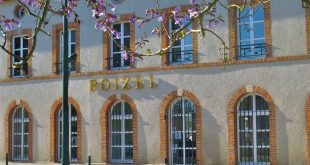

Huangjiu – made from millet, rice and wheat – has been fermented and enjoyed in China for about 4,000 years. It predates today’s more popular baijiu by around 3,000 years because China only really started distilling alcohol during the Southern Song Dynasty (1127 – 1279). So, when you see 3,000-year old Chinese antique bronze wine cups, remember that they were used to savour huangjiu, not Maotai.
You can also be quite sure that when strongman Wu Song defeated the tiger in the classic novel “Water Margin”, the 18 bowls of jiu he downed at the tavern were rice wine, not baijiu.
Pagoda is Shaoxing’s most respected and largest rice wine brand. The winery is located in Xing He Qiao. The back of the winery – where the fermentation takes place – is just next to the bank of Lake Jianhu (just as a whisky distillery would be situated next to a source of water). The pristine clear water of this natural lake goes into every bottle of Pagoda rice wine. Annual production is about 5 million litres.

Chief Winemaker/Deputy Managing Director PAN Xingxiang was born and raised in Shaoxing. His family boasts three generations of winemakers. Pang was mentored by Master Winemaker WANG A Niu (photo on the wall to the left).
Pagoda was the first Shaoxing rice wine to be exported in the 1950s. Around 15% of its production travels oversea, including to Singapore, Hong Kong, Macao, Taiwan, Malaysia, Thailand, Europe, North America and Japan, one of its most quality-conscious markets.
Rice wine aficionados have the Land of the Rising Sun to thank for Pagoda sticking to tradition rather than modernising. The reason Pagoda continues to make their rice wine manually is because their Japanese importer insists the rice wine should not be produced by mechanization. Pagoda particularly prizes the Japanese market because apart from being loyal, it also prefers higher end, more expensive wines. The Shaoxing winery first exported to Japan from the Port of Shanghai 48 years ago in 1972.
Pagoda’s success in Japan did not go unnoticed and won over many admirers. One such was the Zhejiang Grain and Oil Import and Export Corporation which had already invested in the brand in the 1950s. The conglomerate went on to make Pagoda the largest rice wine producer in all of China. Quantity aside, the brand has always been recognised for its high quality. In 1999, the Chinese Government named Pagoda a “Chinese Time Honoured Brand” of the country.
To make Pagoda huangjiu, “Jiu Mu” needs to be produced in the first stage. “Jiu Mu” is made from glutinous rice. First, the glutinous rice is steeped in water from Lake Jian for two days. Then it is steamed. Together with “Bai Yao” or “Liquor Medicine”, the mass of glutinous rice is poured into 500-litre ceramic containers. At this stage, the rice starch is converted to sugar. By adding water and a particular Chinese yeast called “Mai Qu”, the mixture of “Jiu Mu” will now be ready for fermentation.
The second step is to soak a new batch of glutinous rice for 16 days in winter. After steaming, the glutinous rice will be mixed with Lake Jian water, “Mai Qu” and “Jiu Mu” in a container. This indoor fermentation takes four to five days. After that – still fermenting slowly – it will be transferred to smaller 25-litre containers and will continue their fermentation for another 80 to 90 days outside in the open come rain, shine or snow. February and April is when the wine is pressed and fined. It will then go back into the small containers to be further aged.

Pagoda makes a range of rice wines of varying ages. These include 3, 5, 6, 10 and over 10 years. After fermentation, the alcohol level is around 18%. Every passing year, the wine loses about 0.5% in alcohol. By the time it reaches 20 years, it will be about 14% in alcohol. Not unlike a wine made from grapes. Tasting it, it might remind you of a delicious Oloroso Sherry.
Pagoda Chief Winemaker and Deputy Managing Director PAN Xingxiang was born and raised in Shaoxing. He hails from a family that boasts three generations of winemakers. After graduating from high school the young man started working at Pagoda learning winemaking from his father. At the same time, Pan was mentored by Master Winemaker WANG A Niu, so very highly regarded that he was named a “Guardian of Shaoxing Wine Production of China Intangible Cultural Heritage”. At a ceremony in 2010, an 86-year old Wang handed his protégé a book comprising 60 years of his huangjiu making experience entitled Shaoxing Wine Making Techniques.
?Ang Leong Huat


